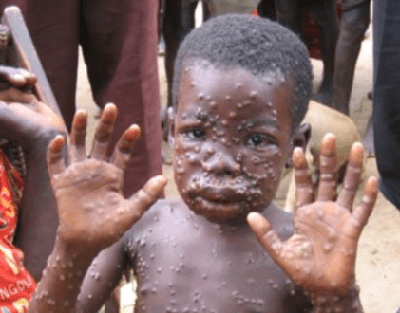Although the Federal Government has assured Nigerians that the outbreak of the viral disease, monkeypox is under control, it is imperative for all citizens to acquaint themselves with the facts on the disease in order to know how best to prevent it.
According to he World Health Organisation statement on the disease, it showed that it is an uncommon condition that occurs primarily in remote parts of Central and West Africa, near tropical rainforests.
 The Apex Health Institution further noted that the monkeypox virus can cause a fatal illness in humans and, although it is similar to human smallpox which has been eradicated, it is much milder.
The Apex Health Institution further noted that the monkeypox virus can cause a fatal illness in humans and, although it is similar to human smallpox which has been eradicated, it is much milder.
The monkeypox virus is transmitted to people from various wild animals but has limited secondary spread through human-to-human transmission.
“Typically, case fatality in monkeypox outbreaks has been between 1% and 10%, with most deaths occurring in younger age groups. And there is no treatment or vaccine available although prior smallpox vaccination was highly effective in preventing monkeypox as well”, WHO
How is it transmitted?
Infection of index cases results from direct contact with the blood, bodily fluids, or cutaneous or mucosal lesions of infected animals. In Africa human infections have been documented through the handling of infected monkeys, Gambian giant rats and squirrels, with rodents being the major reservoir of the virus. Eating inadequately cooked meat of infected animals is a possible risk factor.
Secondary, or human-to-human, transmission can result from close contact with infected respiratory tract secretions, skin lesions of an infected person or objects recently contaminated by patient fluids or lesion materials. Transmission occurs primarily via droplet respiratory particles usually requiring prolonged face-to-face contact, which puts household members of active cases at greater risk of infection. Transmission can also occur by inoculation or via the placenta (congenital monkeypox). There is no evidence, to date, that person-to-person transmission alone can sustain monkeypox infections in the human population.
Signs and symptoms
The incubation period (interval from infection to onset of symptoms) of monkeypox is usually from 6 to 16 days but can range from 5 to 21 days.
The infection can be divided into two periods:
The invasion period (0-5 days) characterized by fever, intense headache, lymphadenopathy (swelling of the lymph node), back pain, myalgia (muscle ache) and an intense asthenia (lack of energy);
The skin eruption period (within 1-3 days after appearance of fever) where the various stages of the rash appears, often beginning on the face and then spreading elsewhere on the body. The face (in 95% of cases), and palms of the hands and soles of the feet (75%) are most affected. Evolution of the rash from maculopapules (lesions with a flat bases) to vesicles (small fluid-filled blisters), pustules, followed by crusts occurs in approximately 10 days. Three weeks might be necessary before the complete disappearance of the crusts.
The number of the lesions varies from a few to several thousand, affecting oral mucous membranes (in 70% of cases), genitalia (30%), and conjunctivae (eyelid) (20%), as well as the cornea (eyeball).
Some patients develop severe lymphadenopathy (swollen lymph nodes) before the appearance of the rash, which is a distinctive feature of monkeypox compared to other similar diseases.
Monkeypox is usually a self-limited disease with the symptoms lasting from 14 to 21 days. Severe cases occur more commonly among children and are related to the extent of virus exposure, patient health status and severity of complications.
People living in or near the forested areas may have indirect or low-level exposure to infected animals, possibly leading to subclinical (asymptomatic) infection.
The case fatality has varied widely between epidemics but has been less than 10% in documented events, mostly among young children. In general, younger age-groups appear to be more susceptible to monkeypox.
It will be recalled that Monkeypox, broke out recently in Yenagoa, Bayelsa capital and about 11 persons have been placed under medical surveillance. While about 49 other persons who had been in contact with the persons infected with the virus are also being tracked by health experts.
The Bayelsa State Commissioner of Health, Ebitimitula Etebu, who had earlier confirmed suspicion of the disease, said samples of patients had been sent to a laboratory in Dakar, Senegal for confirmation.











